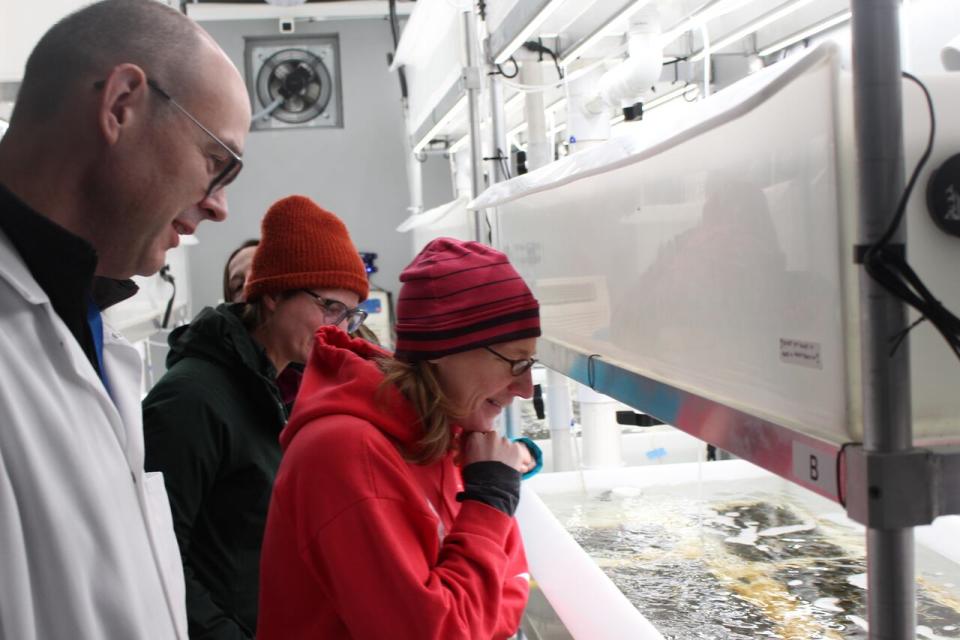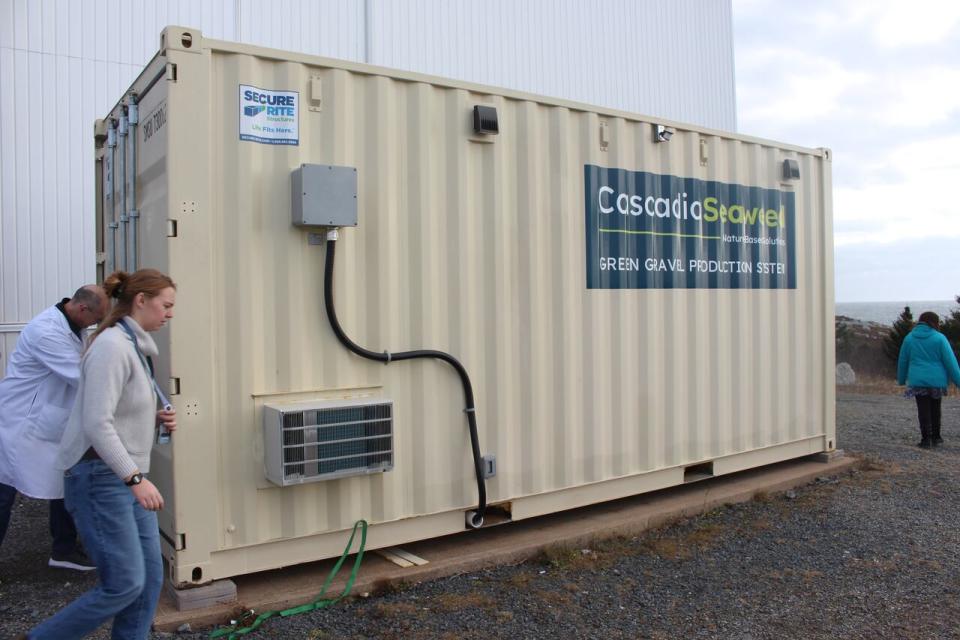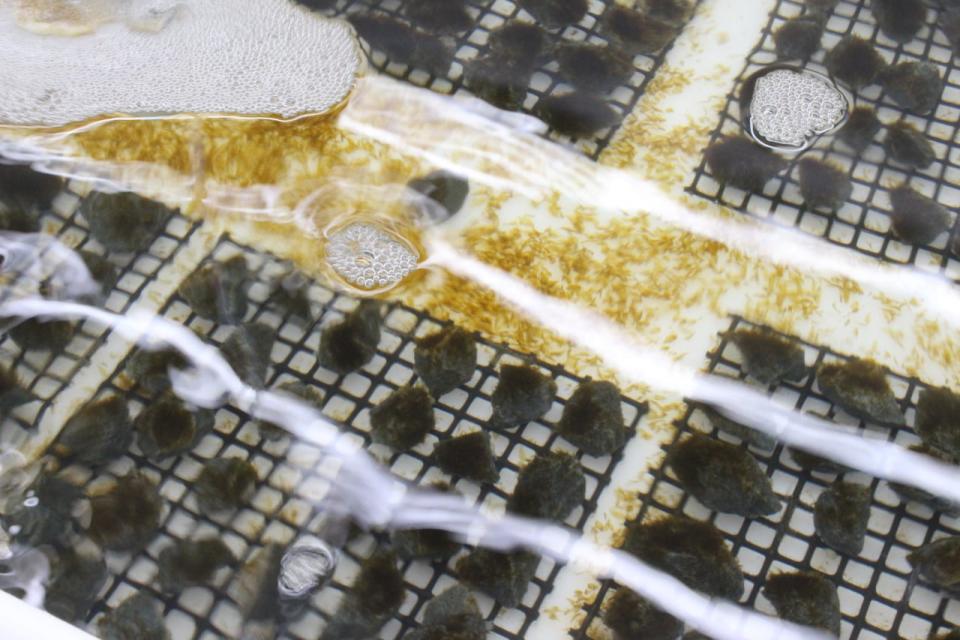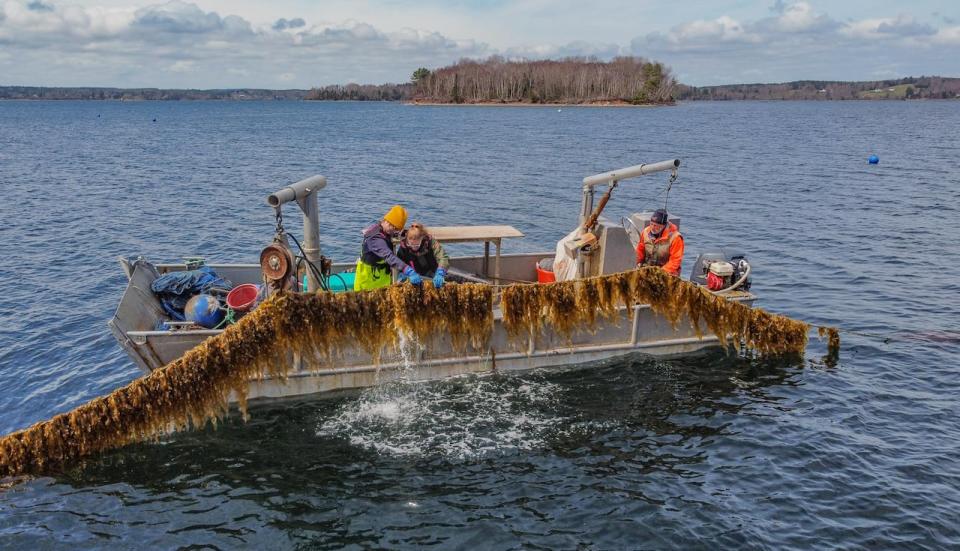In a converted ocean-side shipping container in Ketch Harbor, N.S., a group of people gather to peer into tanks filled with fluffy bits of gravel.
The rocks are covered with small leaves of sugar kelp. Soon, the steel mesh squares to which they are attached will be hung in the water at a kelp farming demonstration site in Mahone Bay, in hopes of protecting Nova Scotia’s future kelp beds.
It’s an initiative of scientists, conservationists and a West Coast company who are collaborating on the restoration technique for the first time in Nova Scotia, although it is used elsewhere in the world.
Kelp is a crucial part of Nova Scotia’s marine environment, providing habitat for a range of other species and removing excess nutrients from the water. But due to warming waters, habitat destruction and pollution, kelp beds are declining, impacting ecosystems.
“We have kelp beds on both coasts that are thinning or perhaps even lost altogether,” said Stephen O’Leary, research team leader at the National Research Council. But with the green gravel technology, scientists hope they can give kelp in Nova Scotia and beyond a better chance at long-term survival.


The people involved in the green gravel project inspect the kelp in the mobile laboratory. (Moira Donovan)
The project involves collecting kelp blades from Mahone Bay in the fall – when declining daylight and cooler water temperatures cause kelp to enter a reproductive state – collecting microscopic spores from the reproductive blades, and using those spores to to ‘inoculate’ rocks. In other words, make sure the spores settle on the gravel.
Sea container is mobile
Those tiny spores are then grown to a size where they are large enough to plant in a specially designed shipping container made by Cascadia Seaweed, based on Vancouver Island in British Columbia. The mobile laboratory is specifically designed for green gravel production and has been tested at the National Research Council’s Ketch Harbor facility, but can ultimately be moved to any location where green gravel is developed and deployed.


The green gravel test was also a demonstration of Cascadia Seaweed’s mobile laboratory, which is designed to be moved to any oceanfront location where it is needed. (Moira Donovan)
During their first test, O’Leary said scientists were initially unsure whether the experiment had worked.
“For three weeks it seemed like we only had tanks for the gravel and it wasn’t clear if anything was growing on them or not,” he said. “So we thought: do we grow gravel here, or do we grow seaweed?”
Then, after a weekend in early December, scientists returned to find the gravel covered with tiny blades of baby kelp.
Normally, the gravel would then be spread into the ocean, where it would settle on the seabed. One or two of the many small kelp blades covering the rocks would survive and grow to their full three-meter length, with the base of the kelp – called the hold – growing around the rock and adhering to the bottom.
In this case, the rocks are attached to 110 square steel meshes that are suspended several meters deep in the water column, allowing researchers to monitor how well kelp grows using this method. Kelp will then grow from December to May.


Landscaping gravel is ‘inoculated’ with kelp by placing gravel in tanks containing microscopic kelp spores, which then attach to the rocks and grow up to half an inch in size before being dumped into the ocean. (Moira Donovan)
“We do not anticipate restoring a kelp bed in Mahone Bay at this time, but we are developing the techniques and technologies that will allow us to undertake that restoration application at a later date,” O’Leary said.
This technology has implications that extend beyond Mahone Bay.
Flora Salvo is an industrial researcher at the Quebec research group Merinov, which is also involved in the project. She said they want to do something similar in Quebec.
Merinov is also working with the National Research Council to build a kelp seed bank. Combining their supply of genetic material with the green gravel technique could enable repopulation of areas where kelp has been degraded or disappeared due to pollution and higher temperatures


A kelp farming pilot project is underway in Mahone Bay, NS. A new report suggests the sector in Nova Scotia could be worth nearly $40 million in three to five years. (Ecology Action Center)
“So having this seed bank could be possible [make it] easy for people who are going to do marine afforestation, using marine gravel technology,” says Salvo.
Ultimately, this could mean replanting areas using spores from individual kelp plants that have been found to be naturally resistant to changing conditions, such as warmer water.
In the meantime, scientists say baseline data on the green gravel technique and its efficacy, as well as more biological data on kelp, could inform restoration regulations. Currently, there are no regulations for kelp recovery in the Atlantic provinces.
Restoration for the right reasons
Shannon Arnold, deputy director of marine programs at the Ecology Action Center in Halifax, said with more scientific attention and investment in kelp recovery, guidelines are needed.
By participating in the green gravel research – including offering the EAC kelp farming demonstration site in Mahone Bay as a location for the experiment – Arnold said they can help answer fundamental scientific questions that influence this process.
“In Canada right now we don’t have really strong guardrails and guidelines on best practices for restoration,” Arnold said. “That’s something we’ll be working on with other groups to see what we need to guide these types of things.”
Arnold said the hope is that the involvement of various groups in the green gravel project will help develop restoration practices that make a positive difference – including the recognition that kelp’s long-term future is best assured not through restoration , but by addressing the underlying reasons for this. the decline of the kelp.
“Our primary focus should always be: protect first, then manage, and then recovery is your last chance, because recovery is very difficult to do,” she said. “We want to make sure we’re doing restoration for the right reasons and in the right places.”
MORE TOP STORIES